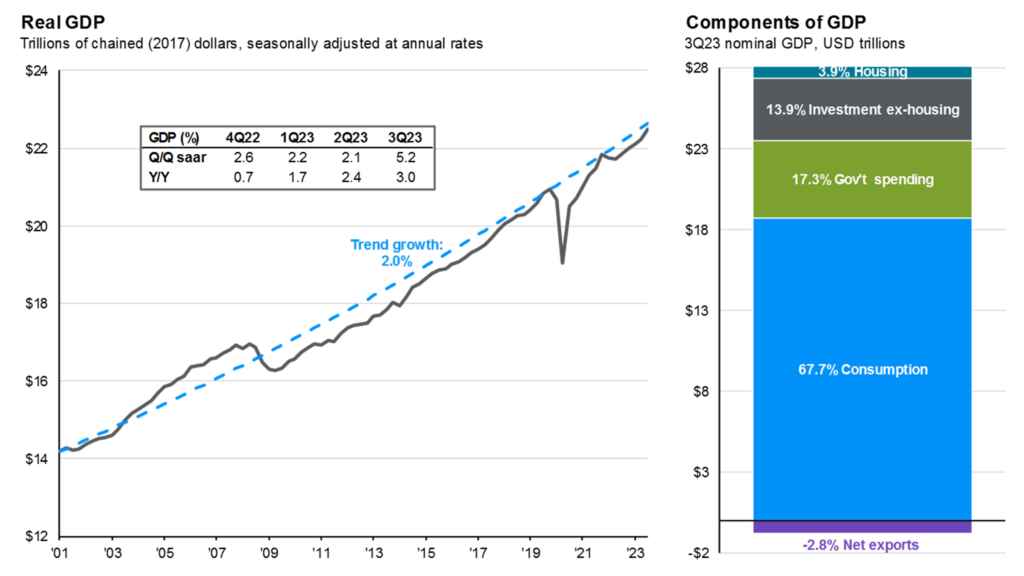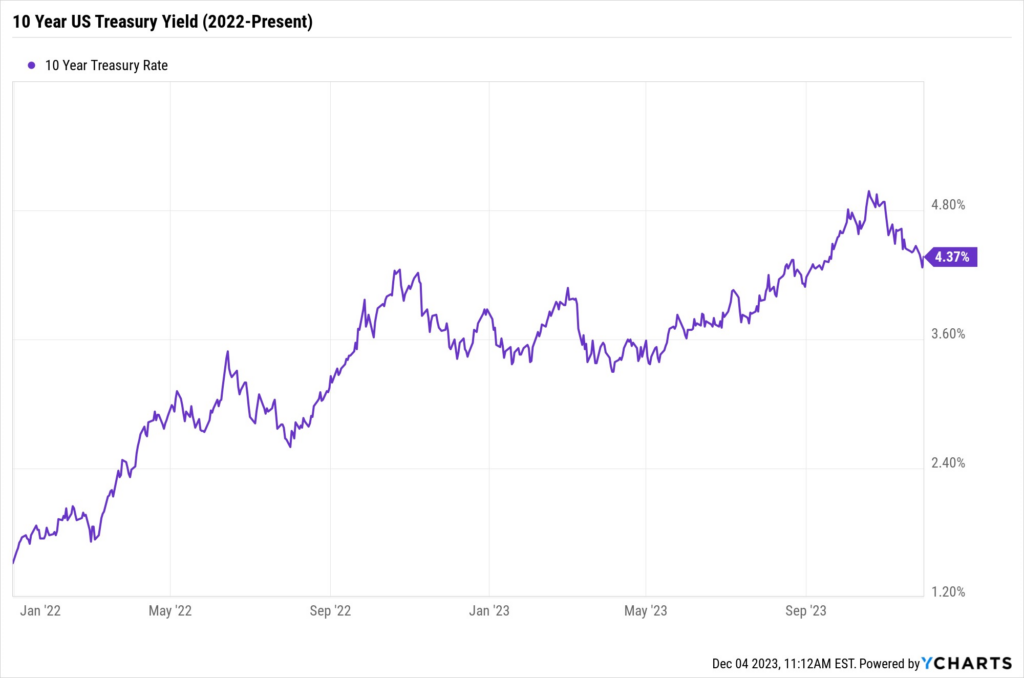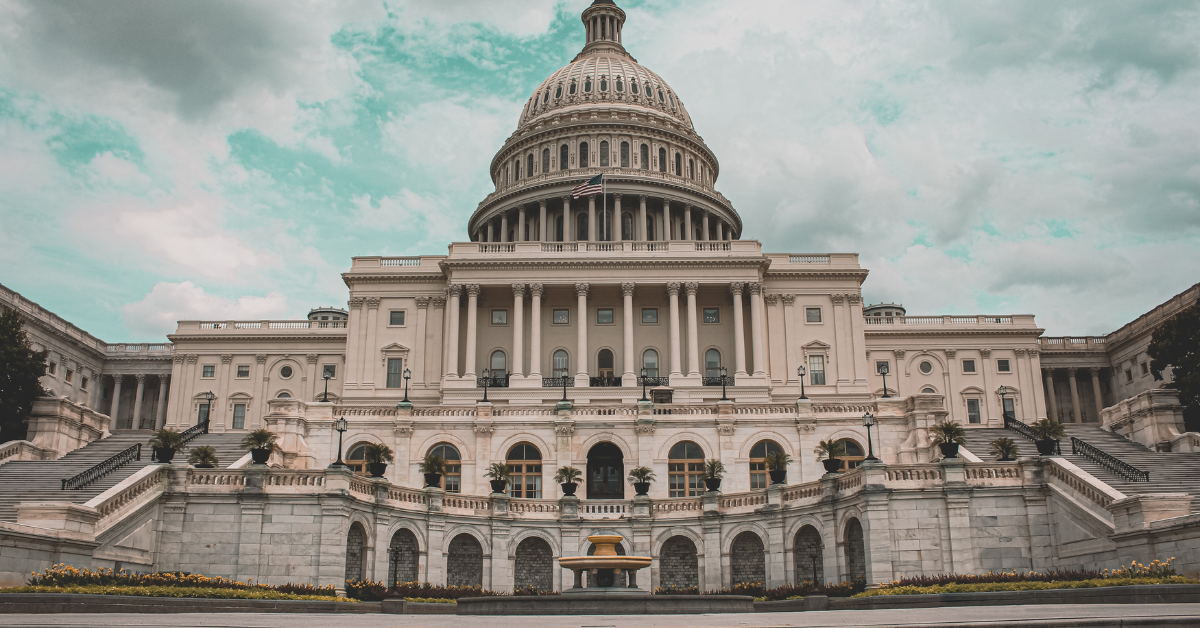By Chirag Sharma & Jack Hounsell
Key Takeaways
- As inflation trends lower, healthy consumer spending will be one of the keys to the Fed orchestrating a soft landing, but there are signs it is starting to slow which could weigh on growth
- The government now has until January 19th to avoid a shutdown, however, the market impact of these events has historically been muted
- Bond yields fell sharply in November as investors are gaining confidence that the Fed is done hiking and inflation will remain under control
Consumer
Consumer Confusion
As of Q3 2023, consumption made up 68% of GDP. The money we spend plays a vital role in the health of the economy. For this reason, economists and analysts pay extra attention to any indicators that gauge consumer sentiment and in which direction these various indicators are trending. However, these indicators don’t always point in the same direction, which may cause confusion when attempting to pinpoint how the consumer is feeling. One of the confounding experiences for consumers is within the housing market. Prospective buyers are reading the tale of two markets when it comes to residential real estate. After a volatile 2022, the pace of new home sales has stabilized around the pre-pandemic rate. With supply of existing homes still below 50% of its pre-pandemic level, homebuilders stand ready to take advantage of any increase in demand. Currently, activity is strongest in the Midwest and West, with supply chain issues and inclement weather negatively affecting builds in the Northeast. Amid low inventory of existing homes on the market, analysts believe that new home sales will likely remain stable to meet the demand. As mortgage rates fall and the Federal Reserve (Fed) pivots away from hiking rates, homebuilders might expect continued growth in business activity.
In addition to stabilizing demand in the housing market, consumer confidence in November rose from the previous month. As prices for durable good fall, consumers retained an appetite for purchasing major items, such as cars, big appliances, and homes. However, the three-month average for consumer confidence fell for the third consecutive month, reaching the lowest since August 2022. Analysts continue to state that continued consumption is highly dependent on the job market. Respondents to the consumer confidence survey reported that jobs were becoming harder to find. If the labor market were to begin cooling, investors should expect consumer spending to slow down.
Lastly, the recent Q3 GDP revision on 11/29 was pushed up from the first estimate of 4.9% to 5.2%. Consumer spending was revised down from 4.0% to 3.6%, but government spending was revised up. Analysts state that consumer data is often revised downward as the economy downshifts and we see this in the latest GDP report. The bottom line is the Fed could find themselves in a sweet spot. Inflation is trending lower, the consumer is still spending but at a slower pace, and the Fed could end its rate hiking campaign without much pain inflicted on the economy.

Washington
Government Shutdown
Congress avoided a government shutdown in November when they passed a temporary funding package. The bill, which passed through the Senate with an 87-11 tally, will keep the government funded through the holidays and into next year, with two new deadlines now set for passing a longer-term bill: January 19th or February 2nd depending on the federal agency. Government shutdowns can understandably give investors some jitters, but historically, markets have largely been indifferent to shutdowns. In contrast to a debt ceiling breach, where all federal spending – including interest payments on U.S. Treasury debt – is threatened, a government shutdown allows for all essential government functions to continue operating uninhibited.
Given the relative lack of direct implications on financial markets, it is unsurprising that S&P 500 performance during government shutdowns has largely been random. Over the course of 22 shutdowns since 1976, the S&P 500 has been up 12 times and down 10 times, with a median return of +0.1%. These shutdowns ranged from one day (1980, 2018) to 35 (2018-2019) with no real relationship between length and market returns. Perhaps more notably, stock market returns 12 months after a shutdown have been overwhelmingly positive. Over the same 22 shutdowns since 1976, the S&P 500 has been higher 12 months later 19 out of 22 times, with a median return of +12.3%.

Fixed Income
Yield Volatility
Last year saw one of the largest drawdowns in fixed income history, with the aggregate bond index falling 13% and the 10-year yield increasing by 2.4%. This was a result of one of the fastest rate hiking cycles in Fed history. This led investors to believe that 2023 would see less volatility and potential return to normal in the fixed income market. However, markets oscillated as interest rate hikes appeared to be coming to an end. Long-term yields surged and then retreated on investors’ evolving perceptions of future policy actions. Although remaining flat for a majority of the year, the increase in volatility occurred during October and November with the 10-year yield reaching highs of 5.0% in October and then declining rapidly in November to 4.2%.
The level of yields reached in October were levels not seen since the run-up to the Great Recession. The rise in long term yields accelerated following the September 20th Fed meeting, as market participants came to expect that policy rates would stay higher for longer. This was because of commentary from the Fed where they held rates steady and indicated that they were still going to vigilantly watch all economic indicators. They also mentioned that they would be willing to raise rates before the end of the year if necessary. At this time, the odds of a rate hike were about the same as a coin flip, and yields began their rapid rise. As a result of the data dependent attitude of the Fed, investors were hyper focused on the upcoming inflation numbers on October 12th. Core inflation ended up meeting expectations, and headline numbers came in above expectations, which continued to contribute to the remaining run up in yields for October.
In November, bond yields retreated as investors revised down their expectations of future rate paths. Investors were reassured by the November 1st Fed meeting, which suggested that tighter financial conditions made further policy rate hikes less likely. The US Treasury also surprised market participants by announcing a lower-than-expected increase in issuance of long-term debt. Yields kept falling through November as a string of macroeconomic data releases pointed to softer activity and faster than expected disinflation progress, with both core and headline inflation numbers in November coming in below expectations. Similar support came from the release of Fed minutes and comments from Fed Chair Powell at various other conferences.
From an investment standpoint, volatility in yields means volatility in bond prices. This is because yields are inversely related to bond prices, so as yields move up, bond prices fall and vice versa. Through various parts of the fixed income market, there were large swings in prices and returns. In the treasury market, TLT (ETF that tracks long term treasury securities) was down 8% in October but then back up 10% in November as a response to the rapid rise and then rapid decline in yields. In the municipal market, muni bonds were down 2.5% in October, but then returned 6.3% in November. This is the highest return for muni bonds in the month of November for 40 years, which shows how rapid the fall in yields were. Although yields continue to remain volatile, analysts believe that with the Fed likely done hiking rates and yields at attractive levels, bond returns have become increasingly competitive with equities.

